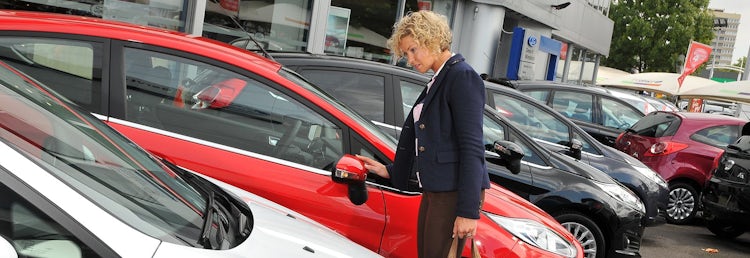Used Ford Puma cars for sale
Find the right second hand Ford Puma for you through our network of trusted dealers across the UK
Looking to buy a used Ford Puma? Get a full car history check
How buying a used car through carwow works
Find a car
Use carwow to browse and compare used vehicles, advertised by a network of trusted dealers. You can search by make and model, or apply filters to find the perfect car for you.
Contact the dealer
Once you’ve found a car you’d like to buy, you can contact the dealer to arrange the next steps, whether that’s asking a question or taking it for a test drive.
Buy the car
When you’re happy to buy, you can do so at a fixed price, safe in the knowledge all models sold through carwow are mechanically checked and come with a warranty.
Used Ford Puma pros and cons
Sell your car for what it's really worth
The free, easy way to get 5,500+ dealers all over the UK bidding on your car
Is a second hand Ford Puma a good car?
The Ford Puma is an alternative to the likes of the Skoda Kamiq, the Volkswagen T-Cross, and the Nissan Juke. It’s cuter and more expressive-looking than the Skoda or the VW, and a bit easier on the eye than the complicated-looking Nissan.
Like those cars, the Puma is a compact SUV, so you sit up a little higher, and there’s more space in the back than you’d find in the car it’s based on — the humble Ford Fiesta. Like the Fiesta, the Puma is also rather more fun to drive than most others in its class.
The name comes from the original Puma coupe of the 1990s, which was also based on the Fiesta, but this current version ditches the compromised practicality of the coupe in favour of a big boot and wannabe 4x4 styling. It’s like swapping a trendy clutch-purse for a more useful tote-bag.
Sadly, the Puma isn’t as nice inside as it is outside. The cabin, also lifted largely from the Fiesta, looks dark and dreary, with lots of cheap plastics. On the upside, the actual way it’s put together is very good, and while a Peugeot 2008’s cabin looks smarter, it’s not as well bolted together as the Puma’s.
The Puma’s cabin does score well on the tech front, with the option of some very handsome digital dials (initially only standard on sporty ST-Line versions, but they did trickle through to other models eventually) and Ford’s SYNC3 touchscreen. More recently, the Puma has been treated to a big-screen upgrade with SYNC4 software, but don’t count out the older system — it’s not as sophisticated, but it’s simple and easy to use, and it sticks with proper physical buttons for the air conditioning and heating. Apple CarPlay and Android Auto connections have always been standard too, while some models have a wireless phone charging pad — very posh.
If there’s a let-down in the Puma’s cabin, it’s that the back seats aren’t very spacious — if you need room for four adults, get a Skoda Kamiq instead.
The big boot does compensate for that, though. There’s a healthy 401 litres of luggage space, including the clever ‘MegaBox’ storage box under the boot floor, which is handy if you need to carry a tall, narrow item in the boot, or if you need somewhere to stash muddy, sweaty sports gear. The MegaBox can even be hosed out, but it does mean that there’s no spare wheel.
The Puma’s no off-roader, in spite of the mini-SUV looks, and it has only ever been available with front-wheel drive, and a choice of 1.0-litre ‘EcoBoost’ engines in 125hp or 155hp forms, or the more powerful 1.6-litre ST version with 200hp. More recently, there’s been a 170hp ST model with an automatic gearbox as standard, which isn’t as sporty to drive as the older 1.6 ST.
Not that that really matters, as even a basic 125hp Puma is a total hoot to drive, with sharp steering and hot hatch-like responses. There’s a down-side to that, though, as the Puma is very bouncy over bumps, and the poor rear visibility means in-town driving can be more of a chore than you’d expect.
What to look for when buying a used Ford Puma
The 1.0-litre EcoBoost engine is a clever unit, and packs a lot of power for such a small engine, but it has some significant and well-documented reliability issues. The biggest of these is the ‘wet belt’ cambelt, which actually passes through the engine’s oil supply as it turns. Over time this can weaken the belt, causing premature failure, while plastic fragments from the belt can cause blockages in the oil system, again leading to engine failure. If you’re buying a 1.0-litre model, make sure that the cambelt has been changed to schedule, and consider changing it well ahead of schedule yourself, along with an annual oil change, to try and conserve the engine’s reliability.
The only engine which avoided this issue was the 200hp 1.6-litre ST version, which uses a timing chain instead of a belt.
In the most recent Driver Power ownership survey, Ford finished third from bottom, in 30th position, in the best brands to own list, although a not-unreasonable 20% of owners reported issues with their cars. The Puma itself finished in a much more credible 10th place overall in the top 50 models to own table, with an owners’ score of 89.55%.
Ford Puma FAQs
Used car buying guides
Popular used car models
- Used Audi A1 Sportback
- Used Citroen C5 Aircross
- Used Fiat 500
- Used Ford Fiesta
- Used Hyundai i10
- Used Hyundai Ioniq 5
- Used Jaguar E-PACE
- Used Jaguar F-PACE
- Used Jaguar I-PACE
- Used Kia Ceed
- Used Kia Niro
- Used Kia Picanto
- Used Kia XCeed
- Used Land Rover Defender 110
- Used Mazda CX-5
- Used Mercedes-Benz A-Class
- Used Mercedes-Benz CLA
- Used Mercedes-Benz GLA
- Used MG MG4 EV
- Used MG ZS
- Used Peugeot 208
- Used Peugeot 3008
- Used Polestar 2
- Used Renault Clio
- Used SEAT Ateca
- Used SEAT Ibiza
- Used SEAT Leon
- Used Skoda Kodiaq
- Used Toyota Aygo X
- Used Toyota Yaris Cross
- Used Vauxhall Corsa
- Used Vauxhall Grandland X
- Used Vauxhall Mokka
- Used Volkswagen T-Cross
- Used Volkswagen Tiguan
* In line with the Consumer Rights Act 2015










